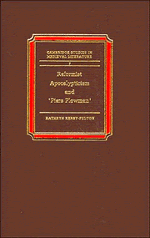Book contents
- Frontmatter
- Contents
- Acknowledgments
- List of abbreviations
- 1 Introduction
- 2 The visionary prophecy of Hildegard of Bingen in relation to Piers Plowman
- 3 Piers Plowman and the medieval visionary tradition
- 4 Leaven of malice: false apostles in the anti-mendicant apocalypticism of later medieval England
- 5 Leaven of hope: new leadership and Joachite apocalypticism
- 6 Conclusions
- Notes
- Select bibliography
- General index
- Index of biblical citations
- Index of manuscripts
2 - The visionary prophecy of Hildegard of Bingen in relation to Piers Plowman
Published online by Cambridge University Press: 15 October 2009
- Frontmatter
- Contents
- Acknowledgments
- List of abbreviations
- 1 Introduction
- 2 The visionary prophecy of Hildegard of Bingen in relation to Piers Plowman
- 3 Piers Plowman and the medieval visionary tradition
- 4 Leaven of malice: false apostles in the anti-mendicant apocalypticism of later medieval England
- 5 Leaven of hope: new leadership and Joachite apocalypticism
- 6 Conclusions
- Notes
- Select bibliography
- General index
- Index of biblical citations
- Index of manuscripts
Summary
INTRODUCTION: HILDEGARD OF BINGEN (1098–1179) AND THE DISSEMINATION OF HER PROPHECIES
The beginnings of later-medieval reformist apocalypticism go back to twelfthcentury Germany, where the Great Reform had had its most profound repercussions; it produced religious prophetic thinkers like Rupert of Deutz, Gerhoh of Reichersberg, Anselm of Havelberg and Hildegard of Bingen, who each tried in his or her own way “to wrest meaning from the great revolution of their times.” The concerns of these German writers left their stamp on the religious prophecy of the later Middle Ages, but none more than Hildegard. Her influence as a prophetess was profound. Along with Joachim of Fiore, Hildegard is the most commonly cited authority in sermons, encyclopedias, chronicles and religious tracts in which authors and compilers chose to include current apocalyptic theory. Chronicles of the period testify to the reputation which she and the younger visionary Elizabeth of Schönau (on whom Hildegard had a great influence) had acquired. In 1158 an annalist wrote: “In these days God made manifest his power through the frail sex, in the two handmaidens … whom he filled with a prophetic spirit, making many kinds of visions apparent to them through his messages, which are to be seen in writing.”
Hildegard carried on a prodigious correspondence with emperors, kings, popes, nobility and clergy all over Europe. Her zeal for evangelism and reform seems to have been the motivation for much of her contact with the world beyond her abbey walls, although as her reputation as a prophetess grew people began to come to her for spiritual advice, reassurance and, one might say,“news” from above.
- Type
- Chapter
- Information
- Reformist Apocalypticism and Piers Plowman , pp. 26 - 75Publisher: Cambridge University PressPrint publication year: 1990
- 1
- Cited by

